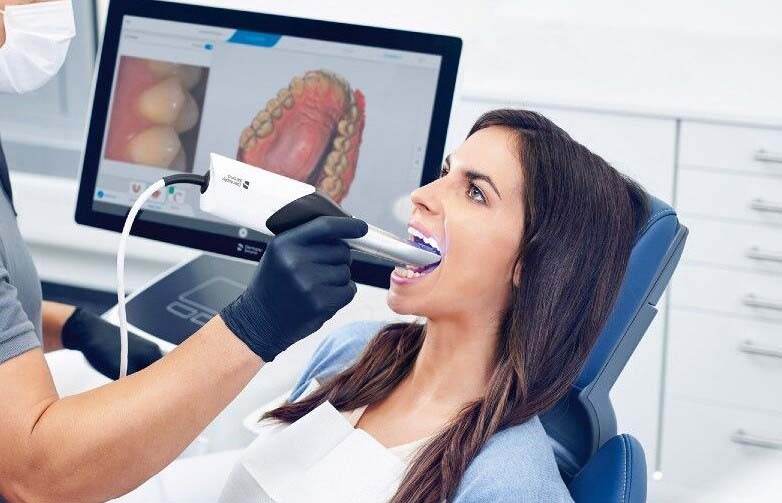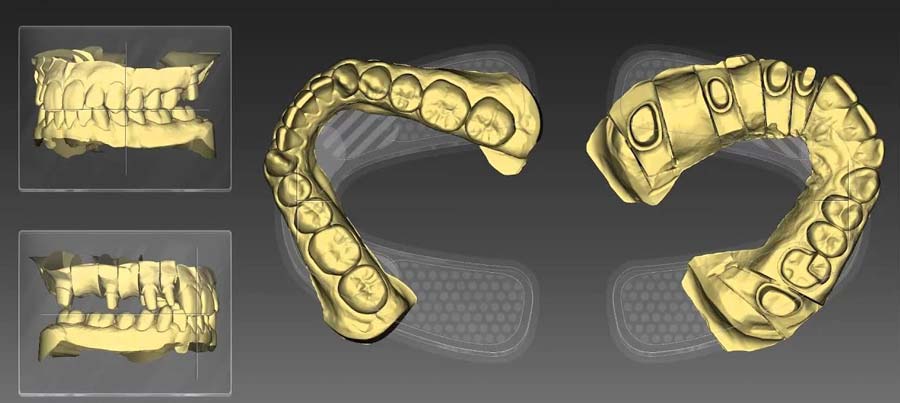A common buzzword that is thrown around a lot these days is “digital dentistry”.
In essence, digital dentistry is just the use of computers, as a tool, to help us treat patients. Broadly speaking, there are three areas where Digital Dentistry comes into play.
The first comes when we scan a patient. Nowadays, intra-oral scanners are able to help us to capture the patient’s mouth in a 3-D format.
This is useful in terms of patient education because you are able to see what exactly we are looking at when we do our exam.
It is also helpful for patients who have very bad gag reflexes, for example. Because scanners allow us to capture the shape of a tooth, this information can go to a lab to help us to manufacture a crown.
Using CAD software, of Computer-Aided Design, we are able to model what we want the eventual teeth to look like and this information can then be sent over to our printer.
That’s where the third portion of digital dentistry comes in. This is the CAM portion of things. Or the Computer-Aided Manufacturing. Labs are able to use a combination of printing and milling to create a whole variety of dental prosthetics.
This ranges from a single crown or an onlay, all the way to a complete denture as well.
Over here at the Dental Implant Center, one of the ways that you will see it in action is when you come in for your first patient appointment. We will do a scan of your mouth so that you are also able to join us in taking a look at what’s going on in places that you don’t usually see.
This information can also be stored digitally so that if we need to retrieve it at a later date, we are able to at any time.
Digital dentistry began with the revolutionizing of the dental information management system. We’ve been using digital patient charts for decades now; digital radiography (x-rays) since the 1990s; and, more recently, computer-aided design and manufacturing processes for all sorts of dental restorations.
In a nutshell, digital dentistry today is just the use of computers to facilitate the prosthetic reconstruction process. Part of the beauty of this is that we can now design and fabricate very complex restorations in newer, stronger materials.
 The first way we implement digital dentistry is when we scan a patient’s mouth. Intra-oral scanners are able to help us to accurately capture patients’ teeth and gums in a 3-D format. This is also useful for patient education, because you are able to see what exactly we are looking at when we do our clinical examination.
The first way we implement digital dentistry is when we scan a patient’s mouth. Intra-oral scanners are able to help us to accurately capture patients’ teeth and gums in a 3-D format. This is also useful for patient education, because you are able to see what exactly we are looking at when we do our clinical examination.
Traditionally, we use impression materials that take several minutes to set in patients’ mouths. Many patients find this uncomfortable at the very least, and intolerable at worst (especially if they have a severe gag reflex). Intra-oral scanning allows us to improve patient comfort by getting rid of the mouthful of goop that everybody dislikes so much. Instead, we use a camera wand to take high resolution pictures from inside your mouth. Multiple small pictures are captured as we move the wand around, and the computer stiches them all together to get a large, accurate 3D model of your mouth.
The next step in digital dentistry is the incorporation of CAD/CAM technology. Using CAD (Computer-Aided Design) software, we are able to model what we want the eventual teeth to look like and this information can then be sent to a machine for fabrication. This is where the CAM (Computer-Aided Manufacturing) portion of things comes in. Labs are now able to use a combination of printing and milling to create a whole variety of dental prosthetics out of acrylic, high-strength ceramics, or even titanium.

 Here at the Dental Implant Center, one of the ways you will see digital dentistry in action is when you come in for your first patient appointment. We will do a scan of your mouth and you will be able to take a close look at what’s going on in places that you don’t usually get to see. Our restorations are also fabricated by advanced dental laboratories that make use of the latest technology to produce accurate, well-fitting, and beautiful restorations.
Here at the Dental Implant Center, one of the ways you will see digital dentistry in action is when you come in for your first patient appointment. We will do a scan of your mouth and you will be able to take a close look at what’s going on in places that you don’t usually get to see. Our restorations are also fabricated by advanced dental laboratories that make use of the latest technology to produce accurate, well-fitting, and beautiful restorations.
Even beyond the benefits listed above, another less obvious advantage of digital dentistry is that these scanned files can be stored digitally and retrieved at a later date, should the need arise, without taking up physical space. This is particularly helpful for situations where you might need the repair or replacement of a prosthetic tooth or dentures at some time in the future.
Digital dentistry is always evolving and has changed dentistry as we know it. Dr. Daniel Tan has extensive experience in using digital dentistry to improve his patients’ outcome. If you would like to find out more about how we can use it to help you, come in for a complimentary consultation where we can discuss your needs and you can see some of this in action!
